Abstract
The oxidation of NADH and accompanying reduction of oxygen to H2O2 stimulated by polyvanadate was markedly inhibited by SOD and cytochrome c. The presence of decavanadate, the polymeric form, is necessary for obtaining the microsomal enzyme-catalyzed activity. The accompanying activity of reduction of cytochrome c was found to be SOD-insensitive and therefore does not represent superoxide formation. The reduction of cytochrome c by vanadyl sulfate was also SOD-insensitive. In the presence of H2O2 all the forms of vanadate were able to oxidize reduced cytochrome c, which was sensitive to mannitol, tris and also catalase, indicating H202-dependent generation of hydroxyl radicals. Using ESR and spin trapping technique only hydroxyl radicals, but not superoxide anion radicals, were detected during polyvanadate-dependent NADH oxidation.
Similar content being viewed by others
References
Hackbarth I, Schmitz W, Scholtz H, Erdmann E, Krawitz W, Phillip G: Positive inotropism of vanadate in cat papillary muscle. Nature London 275: 67, 1978
Grupp G, Grupp I, Johnson EL, Wallick ET, Schwartz A: Effects of vanadate on cardiac concentration and adenylate cyclase. Biochem Biophys Res Commum 88: 440–447, 1979
Borchard U, Fox AAL, Greef KJ, Schlieper P: Negative and positive inotropic action of vanadate on atrial and ventricular myocardium. Nature London 279: 339–341, 1979
Hackbarth F, Schmitz W, Scholtz H, Wetzel E, Erdmann E, Krawietz W, Phillip G: Stimulatory effect of vanadate on cyclic AMP levels in cat papillary muscle. Biochem Pharmacol 29: 1429–1431, 1980
Ozaki H, Urakawa N: Effects of vanadate on mechanical responses and sodium-potassium pump in vascular smooth muscle. Eur J Pharmacol 68: 339–344, 1980
Akera T, Temma K, Takeda K: Cardiac actions of vanadium. Fed Proc U.S.A. 42: 2984–2988, 1983
Sundet WD, Wang BC, Hakumaki MOK, Goetz KL: Cardiovascular and renin responses to vanadate in the conscious dog: attenuation after calcium channel blockade (41786). Proc Soc Exp Biol Med 175: 185–190, 1983
Sharada G, Vidya S, Ramasarma T, Ramakrishna Kurup CK: Redistribution of subcellular calcium in rat liver on administration of vanadate. Mot Cell Biochem 90: 155–164, 1989
Catalan RE, Martinez AM, Aragones MD, Godoy JE, Robles A, Miguel BG: Effects of vanadate on heart protein kinase. Biochem Med 28: 353–357, 1982
Sharada G, Ramakrishna Kurup CK, Ramasarma T: Decavanadate acts like an α-adrenergic agonist in redistributing protein kinase C activity. Mot Cell Biochem 267: 93–95, 1990
Ramasarma T, Crane FL: Does vanadium play a role in cellular regulation? Curr Topics Cell Regl 20: 247–301, 1981
Jandhyala BS, Hom GS: Physiological and pharmacological properties of vanadium. Life Sci 33: 1325–1340, 1983
Ramasarma T, Mackeller WE, Crane FL: Vanadate-stimulated NADH oxidation in plasma membrane. Biochem Biophys Acta 646: 88–98, 1981
Vijaya S, Crane FL, Ramasarma T: A vanadate-stimulated NADH oxidation in erythrocyte membrane generates hydrogen peroxide. Mol Cell Biochem 62: 175–185, 1984
Vijaya S, Ramasarma T: Vanadate stimulates oxidation of NADH to generate hydrogen peroxide. J Inorg Biochem 20: 247–254, 1984
Lakshmi K, Sharada G, Patole MS, Ramasarma T: Vanadate-stimulated NADH oxidation by xanthine oxidase: an intrinsic property. Arch Biochem Biophys 244: 742–749, 1986
Meera Rau, Patole MS, Vijaya S, Ramakrishna Kurup CK, Ramasarma T: Vanadate-stimulated NADH oxidation in microsomes. Mol Cell Biochem 75: 151–159, 1987
Patole MS, Sharada G, Ramasarma T: Vanadate-stimulated NADH oxidation requires polymeric vanadate, phosphate and superoxide. Free Radical Res Common 4: 201–207, 1988
Darr D, Fridovich I: Vanadate and Molybdate stimulate the oxidation of NADH by superoxide radical. Arch Biochem Biophys 232: 562–565, 1984
Liochev S, Fridovich I: Superoxide is responsible for the vanadate stimulation of NAD(P)H oxidation of biological membranes. Arch Biochem Biophys 263: 299–304, 1988
Liochev S, Fridovich I: Vanadate-stimulated oxidation of NAD (P)H in the presence of biological membranes and other sources of 02. Arch Biochem Biophys 279: 1–7, 1990
Patole MS, Ramakrishna Kurup CK, Ramasarma T NADH-ependent polyvanadate reduction by microsomes. Mot Cell Biochem 75: 161–167, 1987
Yoshino S, Sullivan SG, Stern A: Vanadate-mediated oxidation of NADH: Description of an in vitro system requiring ascorbate and phosphate. Arch Biochem Biophys 272: 76–80, 1989
Keller RJ, Sharma RP, Grover TA, Piette LH: Vanadium and lipid peroxidation: Evidence for involvement of vanadyl and hydroxyl radical. Arch Biochem Biophys 265: 524–533, 1988
Winterbourn CC: Evidence for the production of hydroxyl radicals from the adriamycin semiquinone and H202. FEBS Lett 136: 89–94, 1981
Crane FL, Mackeller WC, Morre DJ, Ramasarma T, Goldenberg H, Grebing C, Low H: Adriamycin affects plasma membrane redox functions. Biochem Biophys Res Communs 93: 746–754, 1980
Shi X, Dalal NS: NADPH-dependent flavoenzymes catalyse one electron reduction of metal ions and molecular oxygen and generate hydroxyl radicals. FEBS Lett 276: 189–191, 1990
Kuppusamy P, Zweier JP: Characterization of free radical generation by xanthine oxidase-evidence for hydroxyl radical generation. J Biol Chem 264: 9880–9884, 1989
Lloyd RV, Mason RP: Evidence against transition metal-independent hydroxyl radical generation by xanthine oxidase. J Biol Chem 265: 16733–16736, 1990
Britigan BE, Pow S, Rosen GM, Lilleg DM, Buettner GR: Hydroxyl radical is not a product of the reaction of xanthine oxidase and xanthine. J Biol Chem 265: 17533–17538, 1990
Mason RE, Buettner GR: Spin-trapping methods for detecting superoxide and hydroxyl free radicals in vitro and in vivo. Methods Enzymol 186: 127–133, 1990
Halliwell B: Use of desferrioxamine as a ‘probe’ for iron-dependent formation of hydroxyl radicals. Biochem Pharmacol 34: 229–233, 1985
Ramasarma T: Generation of H202 in biomembranes. Biochem Biophys Acta 694: 69–93, 1982
Ramasarma T: H202 has a role in cellular regulation. Indian J Biochem Biophys 27: 269–274, 1990
Author information
Authors and Affiliations
Rights and permissions
About this article
Cite this article
Kalyani, P., Vijaya, S. & Ramasarma, T. Characterization of oxygen free radicals generated during vanadate-stimulated NADH oxidation. Mol Cell Biochem 111, 33–40 (1992). https://doi.org/10.1007/BF00229571
Issue Date:
DOI: https://doi.org/10.1007/BF00229571




